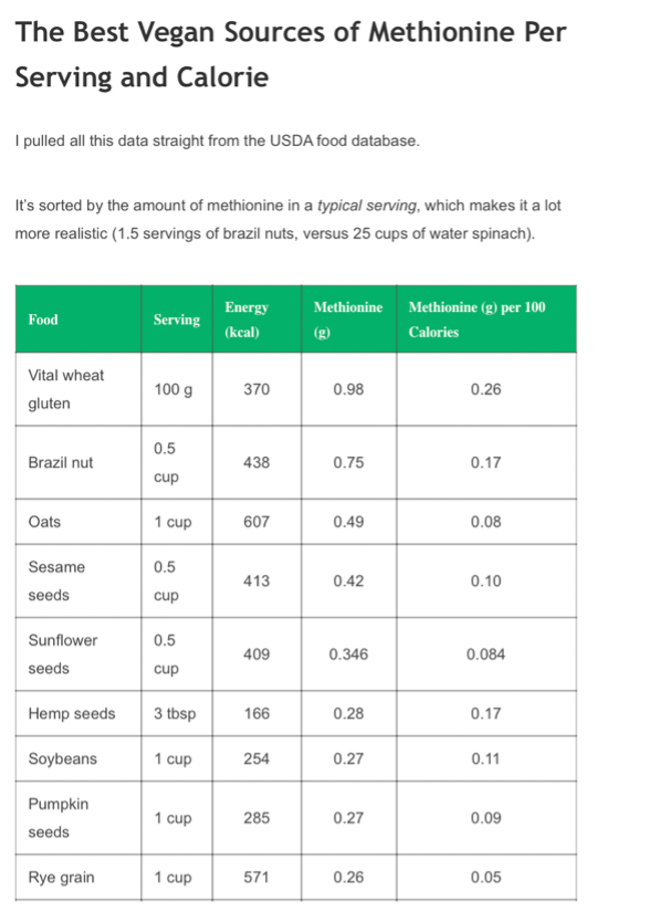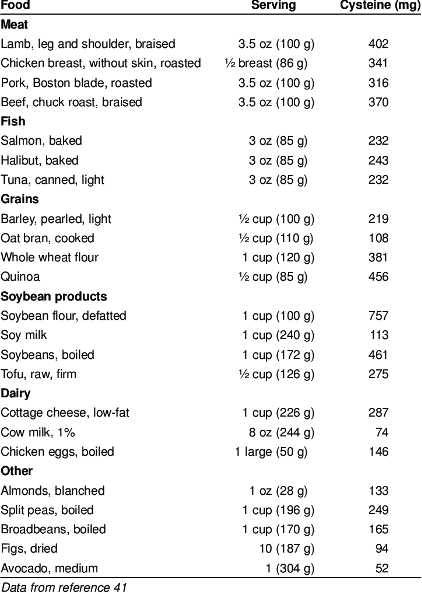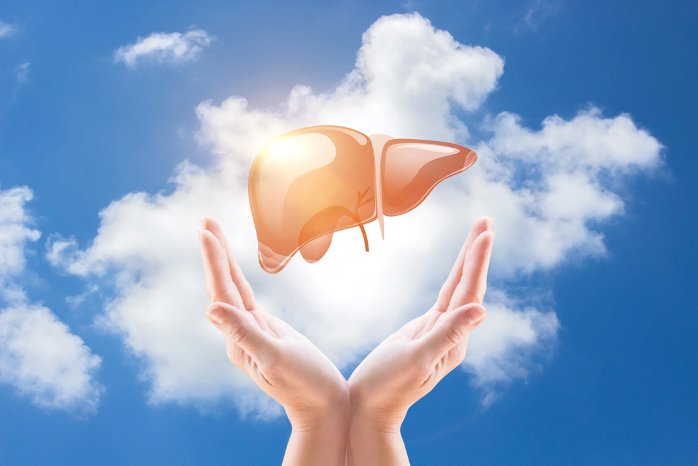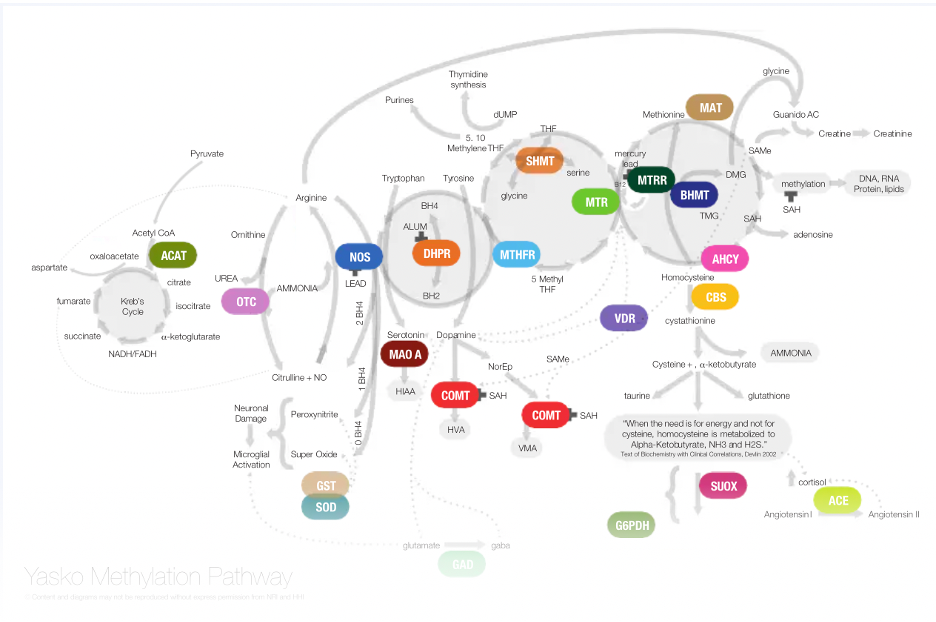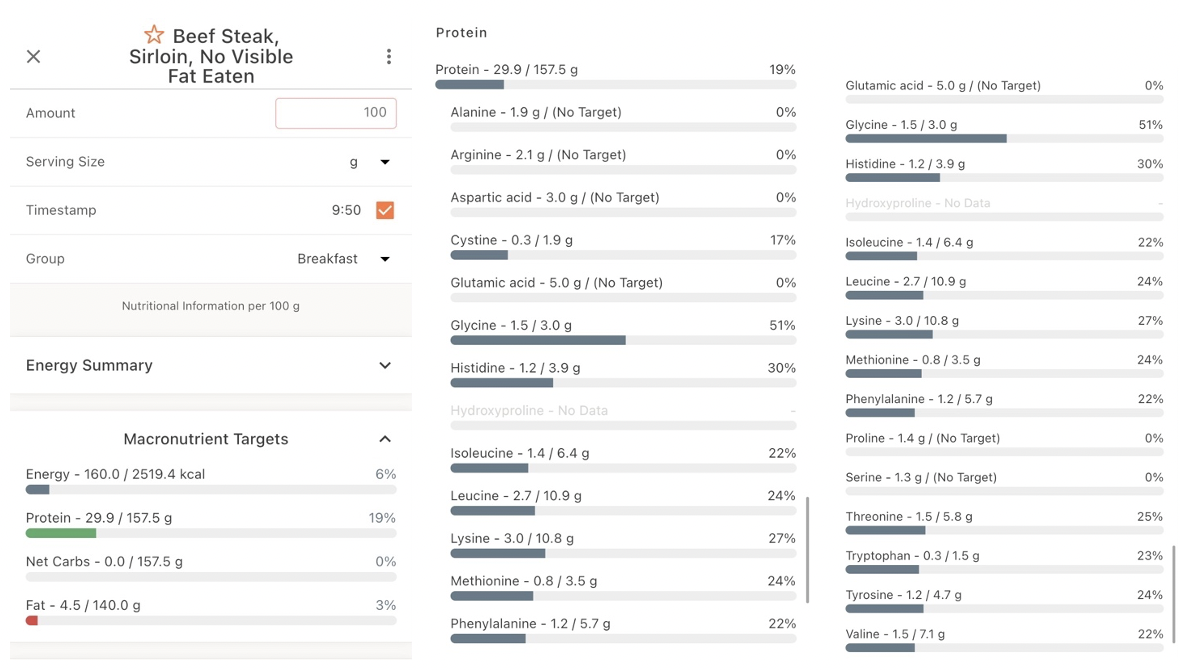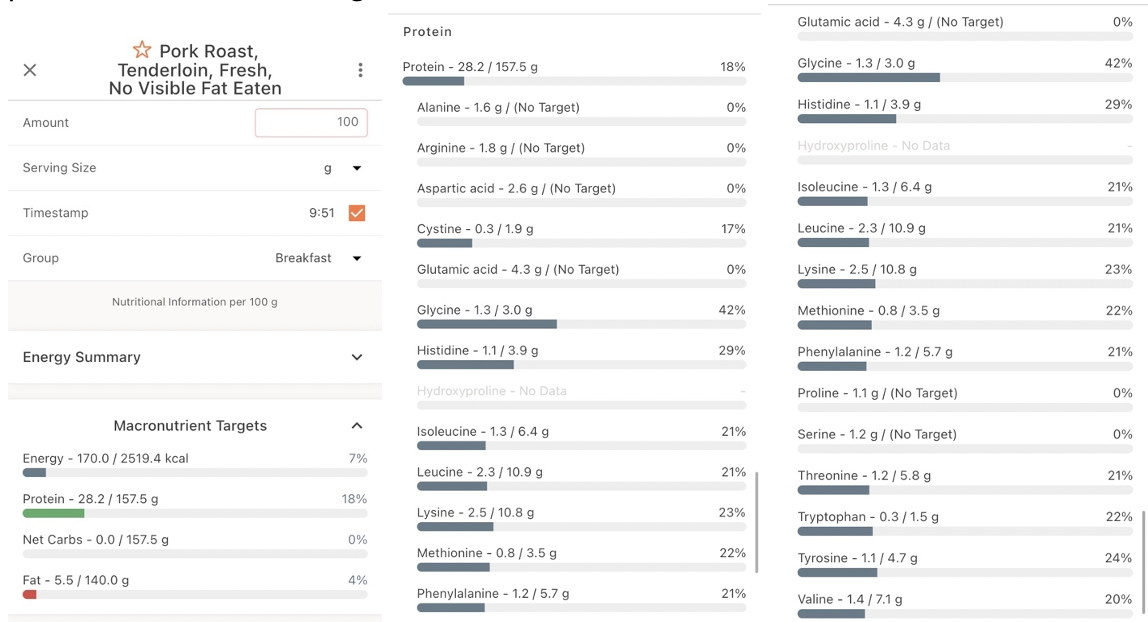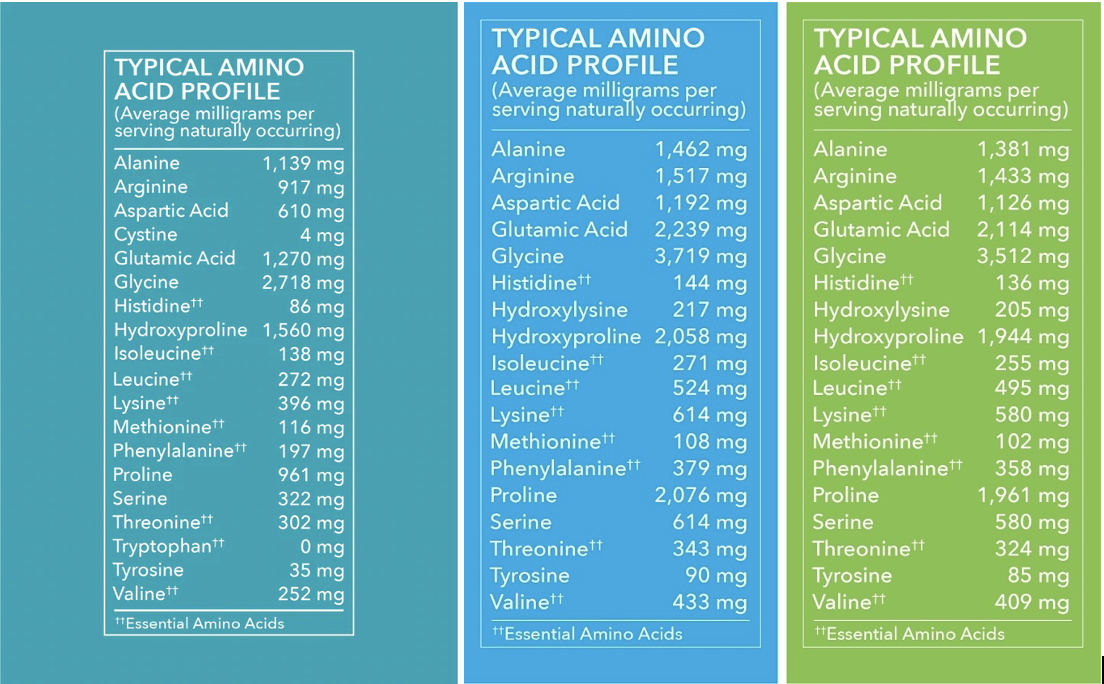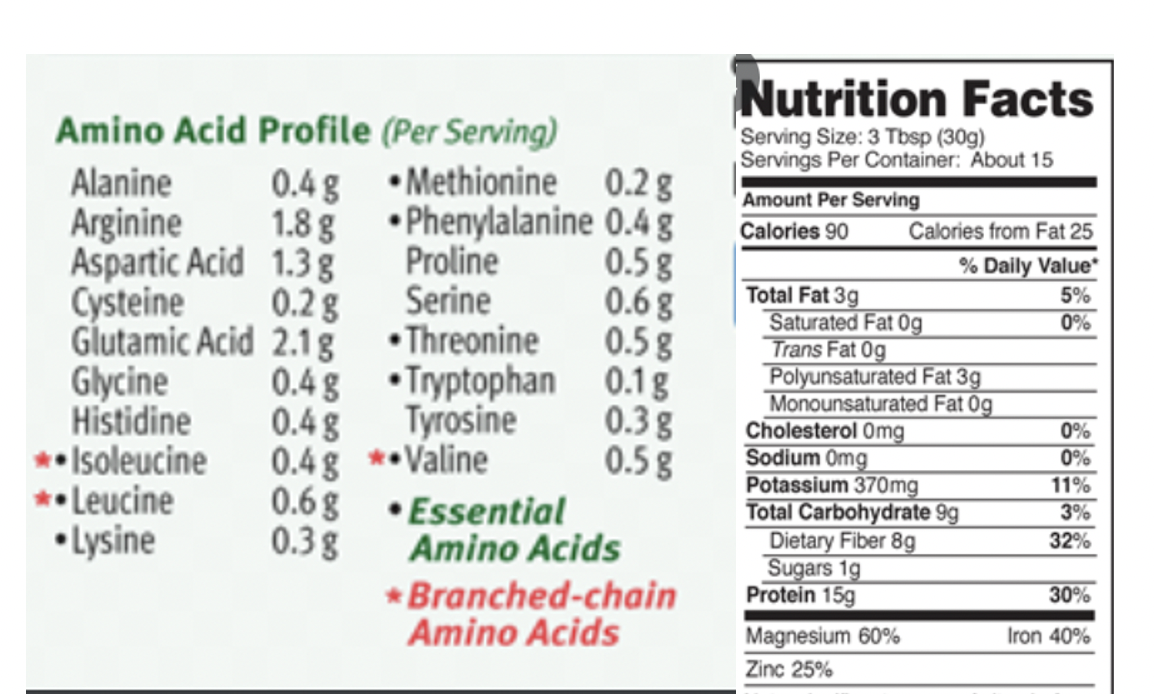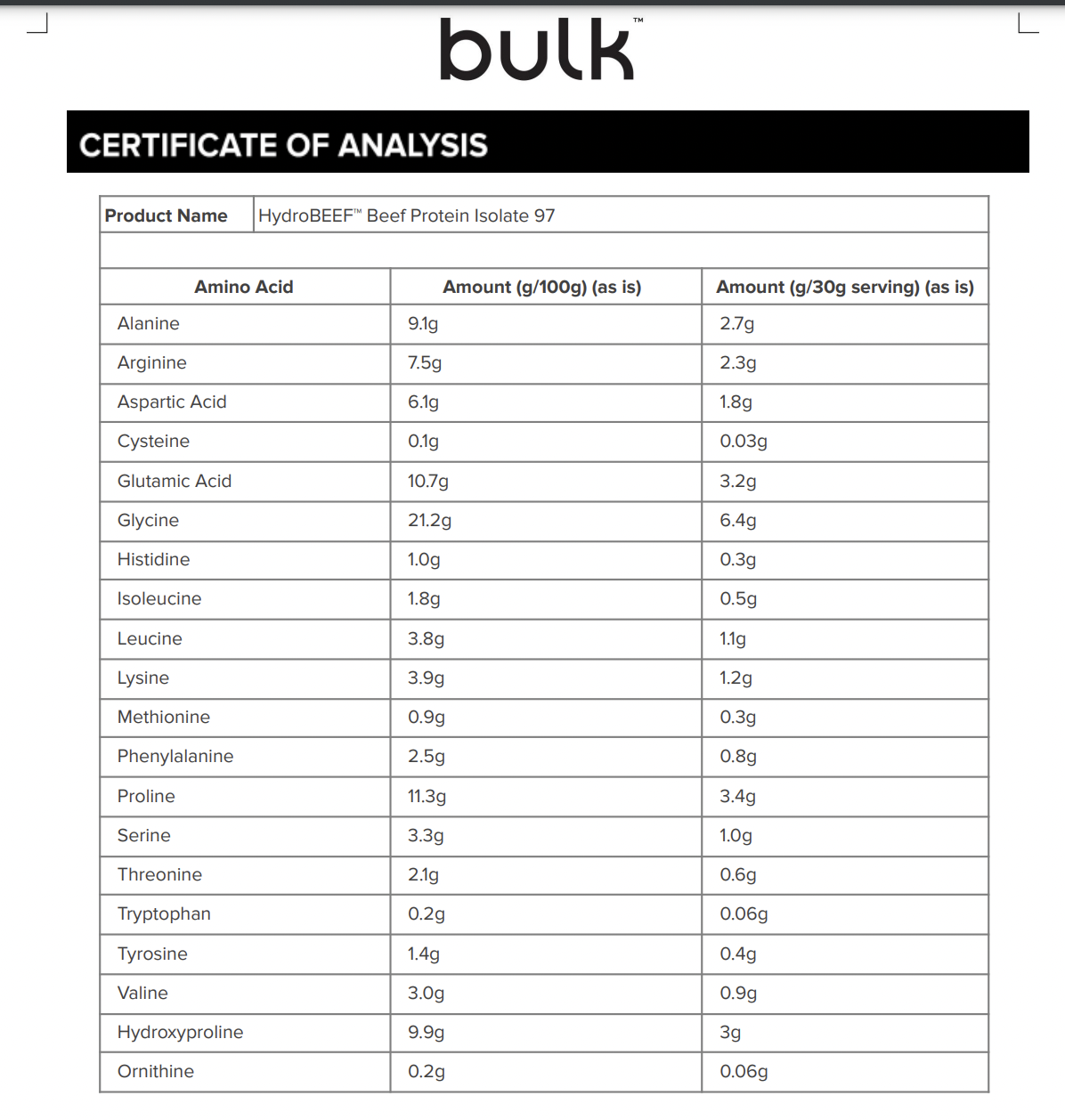A Protein Manifesto: Why You Need Protein With Chronic Illness, Whether Protein Sources Are Adequate, and A Review of The Best Organic, Paleo, Keto-Friendly Protein Powders
[Dietary] protein is the key to life, and protein powders are a great way to sneak in extra protein.
Or are they?
In this article, we’ll talk about the power of protein, why protein is helpful for someone with chronic illness, the ins and outs of protein powders, and a review of which “organic, paleo, keto-friendly, plant-based protein powders” might be best.
Please keep in mind that this analysis is in no means meant to make you fear food! It is simply a science-based opinion on why there are benefits to consuming one source over another.
The Power of Protein
We regularly consume three dietary macronutrients: carbs, fats, and protein. Of these, fat and protein are essential. While carbs contain a hefty profile of micronutrients, we can make energy from fat and protein just fine. The other two? We can’t live without them.
Protein is used to synthesize enzymes (digestive enzymes and enzymes that catalyze other biological reactions), hormones, immunoglobulins, and neurotransmitters.
Phenylalanine, an amino acid from protein, is used a sa precursor for dopamine, epinephrine, and norepinephrine. Source: here
Protein is kind of an umbrella term; protein is really a summation of amino acids. These amino acids are the “building blocks” of just about everything in your body. From bones to hair, skin, muscles, organs (and the cells that make them), nails, and other connective tissues, you’re essentially one big old chunk of protein. Aside from building these important bodily components, they repair them, too.
Although it is not our preferred energy source (ATP), we can use it to make it. However, it is labor-intensive, and we lose an estimated 25-35% of the total energy we consume from protein converting it into ATP! While this might sound like a bad thing, it can be a helpful tool when you’re trying to lose weight and stay warm. If you’ve ever experienced the “meat sweats,” you can attribute it to protein being so dang difficult to turn into usable fuel!
Well, if we “are what we eat,” and if protein is supposedly this important, then it would make a lot of sense that we should eat protein. Right?
I was once told by someone in my vegan days that I should avoid eating protein because my [overactive, self-attacking] immune system was made of protein. In theory, I would be starving this dysfunctional system.
How does a car run when it’s coasting on fumes? How do flower petals look when it’s deprived of water? And how well does a house stand if you’re using makeshift materials?
When we do not give our bodies the raw materials it needs to rebuild and regulate—as we would be if we were depriving it of protein—this is when we get dysfunction.
But aren’t most people eating enough protein? After all, it’s pretty easy to hit the Recommended Daily Allowance (RDA) of 0.8 g/kg. So how is it that we end up in the red?
Where Most Modern Diet “Trends” Have It Wrong, And The “Best Paleo Keto Recipes” Fail
Most of these diet trends focus on carbs and fat. While they allow protein, it is often not a focus. Some, like Dr. Steven Gundry’s lectin-free, even limit it for “longevity,” which is to a lot of followers’ detriments. While eating too many carbs and (or) too much fat is definitely a problem, not eating enough protein—to rebuild your body—might be worse than being too fat! At least, based on my research.
Keto, paleo, AIP, lectin-free, and even whole food plant-based veganism all have you focusing on removing processed foods, which is excellent. But that’s where most of their power ends. Most of these diets give you a “do not eat” food list, including some with a perfectly great nutrient profile that you tolerate just fine. This gives some people some feeling of safety, at least at first. However, that quickly turns to food fear when you’re pushed to wander off the beaten path. These diet trends fail because they do nothing to teach you about the macronutrient quality of your diet or the proportion of fat, protein, and carbs relative to one another. If you look at some of the “best paleo keto recipes,” most of them are just knockoffs of processed foods favorites. This isn’t a health swap by any means if you ask me!
But Modern Guidelines Really Don’t Help
The World Health Organization and the US Recommended Dietary Allowance (RDA) both recommend a modest 0.8 g of protein per kilogram of body weight.
This is the amount of protein estimated to meet 97.5% of the population’s needs. In other words, these are not optimal and are the recommended intakes to simply evade diseases of deficiency.
If you want to take it a step further, there is no individuality to this recommendation. In other words, it doesn’t matter if you’re a 150 lb senior male or a 150 lb active and twenty-something-year-old female soccer player; you still have to consume the same 54.4 g of protein according to the RDA. Now, this definitely doesn’t sound right when we put it into context, does it?
If we are active, sick, healing, or looking to build or maintain muscle, our demand for protein is greater than these general guidelines. However, ‘nutrition experts’ aren’t doing anything to account for this, and fad diet authors aren’t accounting for it, either. It’s not much of a wonder why so many people seem to get sicker on these elimination diets, is it?
So How Much Protein SHOULD I Be Eating?
Protein is super bioindividual. However, I would say that even someone in a vegetative state needs far beyond the RDA of protein (and in their case, they might actually need even MORE to maintain the lean muscle they’re at risk of losing because of atrophy). But I digress. Nonetheless, I tend to recommend people start determining where they are with their current protein intake before they make any changes.
Working towards your goal weight in lbs in grams is usually a more-optimal target for protein. The good ol’ bodybuilding role still holds true. If you’re a 135 lb female, this would mean you’d work your way up to 135 g protein, adding in ten or so grams every week or once you become comfortable. Going from super-low protein (or carbs, or fat) to the opposite extreme isn’t usually the best for the GI tract, nor is it an easy feat to stick to mentally.
Source: ASPI
Because animal protein is usually the most well-tolerated food—except when someone has a red meat allergy, which tends to ameliorate once Lyme is no longer a problem—this also leaves a lot less to guess on what to fill your plate with. These foods tend to warrant the most fear for people with complex and chronic illnesses. It’s kind of a win-win, especially with hypersensitivities.
All Protein Is Equal, Right? WRONG.
So now you’re ready to up your protein, build your body back, and get your health on track. You can just pound all those high-protein veggies you’ve seen on your local vegan influencer’s page, right? Supposedly, you can get all the protein you want from a piece of broccoli. But this is just clever marketing, and it’s caused a lot of people (including myself) some digression and some muscle loss.
Protein refers to amino acids, which are the building blocks of life. There are twenty amino acids the body requires for human metabolism. Amino acids fall into categories based on whether or not we need to get them from food (essential), whether we likely can produce them (conditionally essential), or whether we can definitely produce them on our own from others (non-essential).
Our nine essential amino acids include histidine, isoleucine, leucine, lysine, methionine, phenylalanine, threonine, tryptophan, and valine. You need adequate amounts of these every day to maintain life!
Non-essential amino acids or those the body can produce even if we don’t get them from foods include alanine, arginine, asparagine, aspartic acid, cysteine, glutamic acid, glutamine, glycine, proline, serine, and tyrosine. Some of these non-essential amino acids can become conditionally essential in times of illness and stress, including arginine, cysteine, glutamine, tyrosine, glycine, ornithine, proline, and serine.
Some important roles of the essential amino acids include:
Isoleucine: Isoleucine is one of three branch chain amino acids (BCAA) necessary for skeletal muscle maintenance. It is also vital for glucose transport and immunity.
Leucine: Leucine is another BCAA critical for protein synthesis and muscle health, especially following trauma or injury.
Histidine: Histidine is crucial because it converts into the neurotransmitter histamine. While everyone here is not the biggest fan of histamine, we do need it for arousal and a healthy sleep/wake cycle. Histidine is also critical for repairing damaged tissues and blood cell synthesis.
Methionine*: Methionine is the only essential amino acid with sulfur in it. It also provides a methyl group, which is extremely important for detoxification and histamine metabolization (perhaps the best antihistamine for mast cell activation… in food, that is!)
Phenylalanine: Phenylalanine is a precursor to dopamine via tyrosine.
Threonine: Threonine is known for its role in intestinal health and building and repairing the body.
Tryptophan*: Tryptophan converts to the neurotransmitters serotonin and eventually melatonin. The former is essential for mood, and the latter is vital for sleep.
Valine: Valine is essential for emotional calmness, mental focus, and muscle coordination.
Don’t worry; I haven’t gone off on a complete tangent. We’re still talking about why vegetable protein does not equal steak. Vegans often advertise fruits, vegetables, beans, legumes, and grains as comparable protein sources, but that’s only half true.
Fruits and vegetables do contain protein (which is essentially a collective word for amino acids), but it has only a few of the ones that are “essential.” They also tend to be limited in amino acids like methionine and cysteine, which are dire for processes like detoxification and methylation. For more on why methionine is so important, check out this post I wrote on it.
Remember that we must have methyl donors like methionine (mainly found in animal foods) to metabolize histamine! This is something mast cell diet food lists don’t tell you and what the mainstream “low histamine diet for mast cell” tends to neglect. But anyway…
Some of the richest sources of methionine from plant foods are vital wheat gluten (0.26 g per 100 calories), brazil nuts (0.17 g per 100 calories), and oats (0.08 g per 100 calories).
Source: https://vegfaqs.com/vegan-food-sources-methionine/
In terms of cysteine, lentils, oatmeal, and sunflower seeds are up there, but you’ll still need a lot of them to get what you need. If you’re avoiding nuts, seeds, grains, or legumes for autoimmune and gut-healing reasons, this can become harder if you’re hesitant to eat a lot of meat or follow a plant-based diet.
Considering the RDA (remember, not optimal) for methionine and cysteine is around 1.1 g per day, you’d have to eat a considerable amount of oats, brazil nuts, sesame seeds, sunflower seeds, or hemp seeds to get to your goal. Note: I didn’t include vital wheat gluten considering about 99.5% of my followers are gluten-free. You'll likely need even more if you’re sick, active, or healing from chronic illness.
Most people with autoimmune diseases or chronic illnesses have some type of methylation imbalance. If you’re not familiar with methylation, it’s one of the phase II liver detox pathways. Phase II liver detox involves taking a more toxic, oxidizing, free-radical substance made from phase I and “neutralizing” it, for lack of a better word.
Methylation also regulates gene expression. Genes help control how proteins are made and direct how the body functions. How your environment (how you eat, what you drink, and the energy you surround yourself with) interacts with your genes is known as something called epigenetics. When methylation isn’t working correctly because you’re eating the wrong things or stressing too much, these genes are left on, and the body doesn’t work so efficiently.
Nutrients like methionine (and B vitamins, like B12--which is also found strictly in animal protein—and folate) are so crucial for methylation as they provide the nutrient cofactors and methyl donors we need to drive this process. If we’re not eating them in food, we can exacerbate or even trigger the onset of an epigenetic expression by not giving your body the methyl donors and precursors it needs to carry out the methylation process. An excellent example of this is the methyltetrahydrofolate reductase SNP (MTHFR) when we are not eating adequate dietary folate or not consuming sufficient methyl donors. Because these processes rely on one another, the whole cycle gets thrown out of whack.
Methylation encompasses many more processes than the one shown above and includes those below.
Source: Amy Yasko methylation diagram
So, poor methylation from an inadequate intake of nutrients like methionine, B12, and folate could stress the genes you have. Conditions related to poor methylative function include (but are not limited to):
o Autoimmunity,
o Cancer,
o ADD and ADHD,
o Mood disorders (anxiety, depression, manic-bipolar, schizophrenia),
o Cardiovascular disease,
o Autism,
o Hormonal imbalance (endometriosis, PCOS, infertility),
o Mold toxicity,
o Celiac,
o Fibromyalgia,
o Chronic Fatigue Syndrome (CFS),
o Nutrient deficiencies,
o Mast Cell Diseases like Mast Cell Activation Syndrome (MCAS) / Mast Cell Activation Disorder (MCAD), and
o Environmental hypersensitivities.
Anyway, we have another amino acid to get through.
So, tryptophan. As you can see, we can get a substantial amount of tryptophan if we’re consuming 100 grams of some of these plant foods. However, it’s not closely proportional to calories at all! In many instances, you’d have to consume a massive amount of seaweed, chia seeds, or other seeds to hit the RDA (10 mg/kg body weight/d) for tryptophan. Studies examining the intake of tryptophan required to avoid disorders like depression and anxiety have shown that we need to consume far above this RDA, sometimes up to 2x more! That’s a LOT of chia seeds!
Source: https://vegfaqs.com/vegan-food-sources-methionine/
So, yes, you can get these amino acids from plant foods and not eat so many animal foods, but to get the amount of methionine and cysteine you need, you have to up your quantity of plant foods to get to the end product. This results in eating more calories, and no matter what… energy is always conserved. Energy conservation means energy cannot be created or destroyed, and if you’re eating more calories than you’re burning, you will store energy as body fat. While your argument might be, “but I can just move more to burn it off!” I would argue that that may be true, but your protein demand increases in parallel once you become more active. Why? As you exercise more, your body has to repair itself further. Guess what that requires? Protein!
While we’re on the topic of amino acids, there are two ratios of amino acids—or quantities of amino acids we eat—that are important to be kept in proportion to one another. They include the arginine: lysine ratio and the methionine:glycine ratio. These tend to be easy to maintain when animal foods are in the mix but more problematic when their consumption is sparse. For reference, your arginine to lysine (arginine:lysine) ratio should be around 1:1, whereas your methionine:glycine ratio should fall at or below 2:1.
Combining Protein Sources and Increasing Calories
If you really have an aversion to animal protein and are wondering how to up your protein game with plant sources, you can do it. But it gets kind of laborious, and you have to put a lot of thought into it.
Plant proteins tend to contain a portion of amino acids. Others include other clusters. So like a mix-and-match deal, you can throw them together to get a complete profile. The bad thing is that wheat, corn, and soy—some of the most common allergens—have some of the best amino acid profiles. Grains like rice are up there, too, which not many people who are autoimmune like to rely on.
Amino acids commonly missing in plant foods.
Once you have a complete profile of whatever you’re eating or can eat, you must up your calories accordingly to get the optimal target of protein or amino acids in your diet. This can require a LOT of calories because plant-protein sources are not as concentrated in amino acids. For example, to (just) hit the RDA for your daily protein of (59 g at 74 kg or 162 lbs), you would have to eat around 1470 calories in beans and rice (3 cups of black beans, 3 cups of brown rice). Not only is this a LOT of food, but it also leaves very little wiggle room for other foods to fill in your other micronutrient gaps.
Source: Cronometer
To eat a more optimal intake of 100 g protein to heal your body, detoxify, and repair yourself, you’d have to eat around 2495 calories (383 g net carbs!!) of beans and rice. I hope you can understand where I’m coming from now!
Source: Cronometer
So, What Do I Eat to Improve My Protein Intake?
Let me introduce you to Gallus gallus domesticus, Bos taurus, and Sus scrofa domesticus. What are these, might you ask? The common chicken, beef cow, and pig.
If we were to eat 100 g (weight) of a lean piece of chicken (breast), the micronutrient and macronutrient profile would look something like this:
Source: Cronometer
If we were to eat 100 g (160 cal) of a lean piece of beef (sirloin), the micronutrient and macronutrient profile would look something like this:
Source: Cronometer
And if we were to eat 100 g (170 cal) of pork tenderloin, the micronutrient and macronutrient profile would look something like this:
Source: Cronometer
For time’s sake, consuming the RDA of 60 g (346 cal chicken) of protein would look like this:
Source: Cronometer
And hitting 100 g (562 cal) of protein would only look like:
Source: Cronometer
So essentially, you’d be consuming the same amino acid profile (in one place) for 1900 fewer calories if you were to consume 100 g protein from chicken, beef, or pork compared to a whole food vegan source. As I mentioned earlier, this would give you the ability to get the rest of your vitamins, minerals, and essential fatty acids from other fruits, vegetables, nuts, seeds, and whatever else you can fill your plate with.
“But I don’t like animal protein….”
Why You May Have Lost Your Taste for Animal Protein
Interestingly, a loss of taste for animal proteins like meat has been linked to zinc deficiency. Not only is zinc essential for regulating the pituitary and hypothalamus—the master glands in charge of regulating just about everything, including when you salivate—but it is also necessary to produce stomach acid. If you remember my blog post on digestion, A Complete Guide to Intestinal Permeability: What It Is, Why You Have It, and How to Support It, zinc is one of the critical cofactors (or ingredients) to make stomach acid. Guess what foods are high in zinc?
Animal proteins are the best, most bioavailable source. And this is well-known. While some nuts, seeds, and beans may contain small amounts of zinc, they are offset by the phytic acid (phytate) in plant foods. Other factors (that can be really high in plant foods) known to inhibit zinc absorption include a high copper consumption, consuming a lot of foods with a high cadmium content (you can check out my IG post on what foods contain these), or a toxic burden of cadmium, and a high mercury content (again, see IG post) or mercury burden. Birth control (especially exogenous estrogen) is also known to deplete zinc and increase copper levels.
A phytate molecule (found in plant foods) can inhibit zinc absorption.
Aside from stomach acid, zinc is also essential for:
Immunity
Neurotransmitter metabolism and synthesis (healthy mood)
Antioxidant production (superoxide dismutase enzymes)
Hormone detoxification
Heavy metal detoxification (one of the key minerals required by the body for mercury, lead, cadmium detoxification and to keep nickel and copper from becoming toxic)
Thyroid function
Regulation of the hypothalamus-pituitary-adrenal axis
So get onto incorporating some protein from animal foods in your diet!
But, “My Digestion Feels Really Heavy When I Eat Animal Products!”
When I went vegan in 2014, I removed animal products because I was not digesting them well. My inability to digest animal protein was a symptom of low stomach acid; it was not a cause. Because zinc is such a necessary precursor for stomach acid production, simply eliminating these high-zinc foods made my issues worse over time. Stress, antibiotic overuse, and other practices definitely contributed to my problems, but cutting out meat likely helped me dig a hole I couldn’t recover from.
If supporting your stomach acid production is not making much difference, you may want to evaluate coinfections like H pylori or heavy metal toxicity. Both are known to inhibit stomach acid production. Similarly, developing a routine (that’s free, mind you) to support stomach acid production is also helpful. Note: betaine with H pylori is contraindicated! Work with a practitioner to figure out what’s right for you.
What About Collagen and Gelatin? Can’t I Just Add Those? They’re Animal Protein!
The short answer and explanation: no.
The long explanation is still a no, but let’s explain why: While collagen and gelatin are animal proteins, they are highly processed, refined, nutrient-poor animal proteins. Collagen refers to a family of proteins that make up connective tissues. These are usually taken from leftover beef and pig parts (type I and III) and chicken parts (type II collagen) that were inferior to consume on their own, which can include hooves, hides, bones,
They tend to have a set amino acid profile which usually looks something like this:
Before collagen and gelatin make it into your cute little container, they tend to undergo a pretty laborious process that includes:
1. Pre-treatment and demineralization. The raw materials (“agrowastes”) are freed of fat and minerals, which involves treating bovine connective tissue with an alkaline solution for a few weeks to make it soluble from the starting material. Porcine connective tissue is not as densely connected and requires a one-day acid treatment.
2. Extraction and hydrolysis using enzymes and chemicals. Here, collagen is extracted from gelatin.
3. Ion exchange.
4. Filtration.
5. Evaporation.
6. Sterilization.
7. Drying.
And yes, all that for collagen! Aside from that, this process involves chemical solvents.
In the end, you’re left with the amino acid profile shown above and nothing else. What I mean is that there are no vitamins or minerals to accompany your gelatin or collagen powders as there would be in a piece of meat. Your body uses these vitamins and minerals to synthesize its own collagen and gelatin, so it’s pertinent to have the whole kitten caboodle! I’ve included the vitamin and mineral profile of 140 calories worth of gelatin below.
In comparison, here’s 140 calories worth of chicken liver (and yes, I had to pick a superfood just to make my point).
While we’re on the topic of “eating collagen to support our collagen,” we should highlight that the process of collagen synthesis requires vitamin C, amino acids ( the complete profile), iron, copper, and zinc (yeah, that one again), amongst others. Just because you’re eating collagen does not mean your body will instantly make it. Instead, you need a complete complex of all the micronutrient cofactors to synthesize it.
On another note, gelatin and collagen tend to be high in histamine. If you’re someone diagnosed (by your MD) with mast cell activation syndrome/disorder (MCAS/MCAD) or histamine intolerance, or you’re on a low-histamine diet, these might not be something you want to try.
What About A Protein Powder?
Protein powders can be an option, but they should never be relied on. In other words, they are not a substitute for a nutrient-dense, properly prepared animal-based diet. They’re still extremely processed and contain flavors, sweeteners, and colors (even the paleo ones). They also lack a ton of the nutrients (like zinc!) you need to make proteins of your own. While some of them contain a buttload of synthetic vitamins and minerals, these are by no means equivalent to the natural complex of nutrients that your food provides as-is.
A note on synthetic vitamins and minerals: while it might seem nice to have 1000% of an RDA of a nutrient available for you, these are usually in cheap forms. This comes with a few implications. The body usually doesn’t absorb it well, and you pee a lot of it out. Two, it requires extra steps to make it usable by the body. Three, and possibly most importantly, vitamins and minerals work synergistically (together) and antagonistically (against one another). If you’re consuming a boatload of one nutrient, it will deplete its antagonists over time, creating a deficiency.
Aside from the micronutrient argument, it’s also important to note that protein powders are pre-digested, processed foods (even organic paleo protein powders). Because the digestive process requires work, whole food sources of protein keep you satiated and feeling full much longer. Pre-digested protein powders can keep you full initially, but people tend to experience hunger sooner than if they were to eat the real thing (meat).
Raw ingredient sourcing and processing become difficult when consuming processed foods like protein powders. This includes ‘”grass-fed” and “pastured” proteins; some can disguise other ingredients like flavorings, emulsifiers, and colorings with marketing techniques to make them seem more favorable. You have to research something to make sure every component is good, especially if you’re super particular about what’s going into your body.
On another note, chemical solvents, flavorings, thickeners, emulsifiers, and other additives are all used to produce protein powders, which can be difficult for someone who has a lot of sensitivities. Similarly, for someone looking to begin pinpointing sensitivities, they can complicate things. In a concoction full of five, seven, ten, or even twenty ingredients, it’s challenging to figure out what you’re reacting to.
Proper preparation is vital for a lot of plant foods. Because they can contain compounds like polyphenols, phytic acid, oxalate, tannins, lectins, and other “antinutrients” that can inhibit the absorption of essential micronutrients like vitamins and minerals, some plant protein powders can exacerbate intestinal distress and inflammation. I know I wasn’t the only one who used Vega protein powder to get me to go to the bathroom back in the day!!
So as you can tell, I love protein powders! I’m not 100% against them entirely, but finding a well-sourced, organic, pasture-raised, grass-fed, minimally processed, keto-friendly protein powder can be tricky! Personally, I’m more a fan of the newer paleo protein bars because they tend to have more micronutrients (vitamins and minerals) inside. I’d be lying if I said I never enjoyed one when I wanted something savory-like, when I was on the run, or when I was just too bored to cook protein. It happens, and it’s life. However, I never make them a staple because it’d mean I’d be missing out on all the other micronutrients I need to get myself well, keep myself healthy, and catalyze my metabolism.
The key to finding a suitable protein powder for you is finding the one that provides you with the most amino acids you can get and only using it as an adjunct, not as a staple! Real food first; supplements second!
So, with that being said, let’s get into the analysis of protein powders.
Please keep in mind I have no affiliations with any of the following brands included in this article or any of their competitors.
Collagen and Gelatin (Vital Proteins)
We’ve already talked about collagen and gelatin. For record’s sake, let’s just include their amino acid profiles here.
From left to right, we have Vital Protein’s marine collagen, beef collagen, and beef gelatin. Remember, the RDA is in grams, and 1 g = 1000 mg (35 mg of tyrosine is 0.035 g).
Across the board, all of these isolates are low in essential amino acids like cysteine, histidine (although higher in gelatin), and methionine. Notice how two don’t even list tryptophan! While you can synthesize tyrosine from phenylalanine to make dopamine (if you do not have active PKU), it’s still really low!
On another note, collagen and gelatin also have a considerable high glutamic acid content, which can convert into glutamate. For some people with anxiety, certain pain disorders, autism, inflammation from autoimmunity, ADD, and ADHD, this can exacerbate their symptoms.
About the only time I recommend gelatin and collagen over (or in addition to, I should say) animal protein is if they have a salicylate (phenol) intolerance. This is because the body uses glycine to metabolize these substances.
From a micro and macronutrient standpoint, I think that about caps up my thoughts on collagen and gelatin supplements.
Pea Protein (Nuzest, Little Sipper’s Digestive Support Protein)
I used Nuzest’s European Pea Protein Powder for the pea protein I analyzed. I looked at Lil Sipper’s Digestive Support version of the powder, which contains some digestive enzymes and probiotics. I used it because it’s a favorite in the IBS community and because it’s actually pretty clean as far as processing and manufacturing go. The company has always been transparent about sourcing (European non-GMO pea) and processing (minimal chemicals, heavy metal analysis always provided). This is huge!
From an amino acid standpoint, methionine, tryptophan, and cysteine are low. You will see this in many plant-based proteins because plant-based foods are naturally low in these amino acids.
This powder seems to be fortified with some minerals—some more than others—but I wonder about absorption because peas have phytates. While it claims to remove 100% of the lectins, phytates are not measured, nor do they comment on removing them. Paleo protein tends to be lower in histamine. However, it is known to be high in thiol, which can trigger some people. The question, “is pea protein paleo,” is also still up in the air.
This one contains no gums or fillers, which is a pro. They also use thaumatin—a botanical protein—as a sweetener, which multiple panels have shown to have no known adverse effects. It’s been used by many native cultures for quite some time.
Rice Protein (NutriBiotic)
I’m not really accustomed to good rice protein powders because many people I work with seem to have issues with grains. This one is soaked and sprouted brown rice, which can help remove heavy metals like arsenic and optimize nutrient absorption by deactivating “antinutrients” like phytates.
As far as the plant proteins go, this one is comparable to the pea protein. Tryptophan is still really low, which I’d expect because rice isn’t a great source of it. Other plant foods like seaweed and seeds tend to have higher contents, which is why mixed protein powders can be advantageous. Aside from iron, it does not include any notable amounts of vitamins or minerals.
I always ear on the caution with rice products because of arsenic and other toxins, but that’s just me. Always soak, sprout, and replace the water!
Pea and Rice Protein Blend (Garden of Life)
So I consumed this Garden of Life Vanilla Chai protein powder for YEARS as a vegan. I would be lying if I said that it wasn’t amazing in taste.
It’s marketed as a protein powder that “contains a complete profile of amino acids,” which it does. However, it’s misleading because you’re getting some of the amino acids you need, but not enough!
This marketer was also really sweet and also showed everything in mg, which makes everything look like more. In other words, it only has 0.2 g of cysteine, tryptophan, and 0.25 mg methionine. Cysteine, tryptophan, methionine, and even histidine (you need some of it) are really low, which we could expect. Had they bumped up the content of things like chia seeds or squash seeds, we might see these numbers increase.
Because this powder has several plant sources, it does contain some zinc. However, it also includes a ton of phytates that might keep you from absorbing any of it.
Hemp Protein Powder (Nutiva Hemp Seed Protein)
This is a newer one and a favorite amongst those with MCAD and histamine intolerance. Similar to some of the other plant protein powders, hemp seed is lower in tryptophan. With regard to cysteine and methionine, it’s pretty respectful for a plant. However, I’ve come to find that it tends to add to the problem.
Hemp seeds are extremely high in oxalate. While oxalate can contribute to joint pain, anxiety, GI disturbances, and kidney stones, they’re also known to stimulate mast cell degranulation and histamine production. Because oxalate is known to inhibit mineral absorption, I also wonder how much this interferes with the uptake of magnesium, iron, and zinc that they provide. Until you have a handle on your histamine, I’d really question whether these are helping you or not!
Now onto animal-based protein powders!
Grass-fed Hydrolyzed Beef Protein (Equip, Kelly Levesque’s, Bulk 97% Hydrolyzed Beef)
The new thing on the market is grass-fed beef protein. However, contrary to what you might have in your mind, these do not come from steak. Most are produced in similar ways as collagen and gelatin and come from similar raw ingredients. You can see this in the amino acid profile. They also don’t have the best flavor. I had a hard time finding chocolate paleo protein powders for the brands I used throughout, and some people have issues with chocolate. So for the sake of comparing apples to apples, I’ll be comparing vanilla powders when I can.
Overall, I like grass-fed hydrolyzed beef protein for people that are hypersensitive to what seems like everything because these are low in sulfur (thiols, which can be a problem for people with heavy metal toxicity) but still have some of the other amino acids that tend to be low in collagen or gelatin. They also lack antinutrients.
Kelly Levesque’s BE WELL (#1)
This is a relatively new one I’ve found and what I’d consider the top hydrolyzed beef protein in North America (to my knowledge). It’s made from grass-fed Swedish beef, came with an unsolicited certificate of analysis (for things like bacteria and heavy metals), and it has only three ingredients: hydrolyzed beef protein, monk fruit, and vanilla.
Many people don’t tolerate stevia well because it ferments in the gut, so this one seems to be a nice alternative. Its amino acid profile is decent, but it’s still pretty low in tryptophan (and cysteine, although non-essential), even for an animal-based product. Methionine looks good! For someone with sulfur (thiol) issues, this one is great!
Bulk Protein Unflavored (Europe Only, #2)
Bulk is a bulk company over in Europe. I debated on including them because 1) they're only in Europe, and 2) because the definitive sourcing of their beef is “European Beef” and not a cut and dry “grass-fed” or “pastured beef.” However, you can call your beef “grass-fed” if it’s predominantly fed grass and supplemental grain, but that’s a topic for another day. I was always sensitive to grain-fed meat and have done rather well with it when I’ve been in a pinch. Grass-fed (or beef protein powders in general) are a rarity in Europe as of now (if you know of one, let me know!).
Concerning amino acids, cysteine and tryptophan are low, and methionine isn’t too bad for a beef protein powder. It makes me wonder what piece of the animal they use it from! This one is unflavoured, though, which could be beneficial if you’re sensitive to flavorings. Don’t look at the flavored ones, though; they have acesulfame-K and other synthetics in them!
Originally I had this ranked at #3, but based on the amino acid profile and price point, I’d include this above Equip.
Equip (#3)
Up until a few months ago, Equip seemed to have the monopoly on the grass-fed beef protein powders. I had to pull teeth to find an amino acid profile. To me, it’s a red flag when a company doesn’t have it outright in an easily accessible PDF. From it, we can see that cysteine, isoleucine, methionine, and tryptophan are very low. Based on this, I would assume that it comes from a low-quality collagen derivative.
The stevia and natural flavor are also questionable; many people with GI issues do not do well with stevia (as it’s fermented in the gut), and I’m unsure of the origins of the “organic natural flavors.” This can still be a fancy umbrella word for a chemical cesspool, just from “organic” sources. The vitamin and mineral content is also limited, minus B12.
Designer Wellness Egg White Protein
As far as complete protein goes, egg white protein is about the best you can do. They’re low-calorie and contain beyond adequate amounts of every amino acid. However, it comes with a few drawbacks (like anything).
First and foremost, not everyone tolerates eggs. Eggs contain a lot of sulfur (thiol, cysteine), which can be a problem for someone with heavy metal issues. Eggs are commonly fed GMO, non-organic grains like soy, corn, or wheat. This is known to cause problems in people with intestinal permeability, and pasture-raised eggs fed their natural diets or only non-GMO, soy, and corn-free grains are anecdotally tolerated better. Many of the protein powders contain sunflower lecithin as an emulsifier and stevia, which are questionable for some people. Of course, flavorings and natural flavor are, too. Otherwise, it’s great. Well, there could be one thing.
I asked a question to several manufacturers on my last issue but have not heard back (I will update when I do). When egg whites are raw, they contain a protein known as avidin. Avidin is known for inhibiting the absorption of biotin. Heat denatures this protein, which means cooked egged whites are not a problem. So, I asked whether or not these egg whites were cooked before processing. To be continued!!!!
Grass-Fed Whey (Levels USA)
Whey and casein are undoubtedly the best complete sources of amino acids. However, not everyone can tolerate them because of lactose, casein, or whey intolerances. Work on healing the underlying cause of your lactose intolerance, and these may work for you!
The only other detriment to dairy-based protein powders is that they contain a lot of thiols, which (again) can be a problem if someone has heavy metal issues. Some, like the Perfect Keto protein powder, also had gum acacia in it, which can be a problem for someone with intestinal overgrowth. Aside from these potential obstacles, just make sure you buy grass-fed! These often tend to have the best flavor and texture if you ask me anyway!
Is Whey Protein Powder Keto Friendly?
The paleo community has all but shunned dairy-derived protein powders like whey and casein, which I think is a bit unruly considering their nutrient content. But is whey protein powder keto-friendly, or should people on keto avoid them too?
Any food can be keto if you make it keto. Similarly, you can eat enough of most foods and make them un-keto. While a food might change the number of ketones you’re registering on a meter, the nutrient content tends to be better in some of these foods. If you’re avoiding a food based on whether or not it’s keto, I would push you to try prioritizing nutrient density instead. Unless you’re using therapeutic keto for a specific condition like cancer, neurodegeneration, or epilepsy, you may see more benefit from focusing more on vitamins and minerals. What can your food do for you?
With all that being said, whey and casein may push you out of ketosis for a bit. However, if you time it around exercise, you may be more inclined to use up the carbs and protein quickly so you can minimize your time out of ketosis.
Grass-Fed Casein (Muscle Feast)
While casein has a lower cysteine content than whey, it’s still pretty significant. On the Brightside, it is lower calorie, though! But back to cysteine, we can make it so this isn’t as much of a concern; I just note it because so many people who rely on protein powders struggle to get enough of it.
I'm not sure of either dairy-based protein powder's vitamin and mineral content. But similar to whey, I would grab the beef protein powder if you have issues with thiols or dairy. And find a good source
Soy Protein Isolate
I don’t recommend soy-based protein powders for a lot of reasons. While it does have a stellar amino acid profile, soy is one of the most genetically modified (GMO) crops on the market. No matter what you think or feel about GMO proteins themselves, soy is usually genetically modified to withstand large amounts of proteins sprayed upon it. This transfers into you, and it tends to work like an antibiotics on your microbiome. High pesticide consumption in humans has been linked to birth defects, autoimmunity, autism, ADD, ADHD, cancer, and metabolic syndrome (amongst other things).
Aside from what is on soy, what is in soy has some downsides, too. Soy is high in phytoestrogens, which may be helpful for post-menopausal women. However, our environments are inundated with xenoestrogens from plastics, food, water, and drugs. While this is not only unfavorable for men, it is also terrible for women. Soy has been shown to exacerbate and trigger estrogen-dominant conditions like endometriosis, breast cancer, prostate cancer, infertility, mast cell activation syndrome, and more. Soy is a common allergen, and this is in part because it is so difficult to digest. It is known to contribute to intestinal permeability, which can trigger autoimmune conditions. If you have a condition like Hashimoto’s, I would especially look to phase out soy because of its relationship to the thyroid. Other compounds within soy are also questionable, as soy contains a high amount of phytates, tannins, and other nutrient-blocking “antinutrients”.
Aside from that, it is also known to have estrogenic properties. If you have a mast cell disorder, histamine problems, an autoimmune condition, or hormone imbalance, soy and soy-related products might be worth swapping out. Soy is a common allergen!
What Google Says The Best Low Histamine Protein Powder Is
Does Whey Protein Powder Have Histamine? What about beef protein isolate? Is rice protein powder low histamine?
When asking le google what the “best low histamine protein powder” is and “best protein powder for low histamine diet,” I got this:
While this may have been written with good intentions, I don’t think that any protein powder is superior to a whole animal protein for someone with histamine intolerance or mast cell activation. These ingredients are highly processed and therefore harbor a lot of histamine on their own.
Given they are amino acid isolates, they can contain higher concentrations of histidine than other balancing amino acids on top of the histamine present from an aging, packaged food. Thus, there is no one-size-fits-all mast cell protein powder. What foods trigger mast cell degranulation varies from person to person, and so do the “antinutrients” they contain. Thus, some of these protein powders may be more or less stimulating for someone.
Some plant components (like oxalate) can stimulate the degranulation and release of mast cell mediators like histamine and further contribute to inflammation because of their thiol content. Aside from the constituents we already talked about, chlorella and spirulina tend to exacerbate thiol issues (they are monothiols) and redistribute heavy metals (not remove them). They also can contain questionable amounts of heavy metals which transfer to you!
The best protein for:
Amino acids
Zinc content
Other micronutrients
Absorption
Satiation
Bioavailability
Tolerance (via the immune system)
…Is a high-quality animal source like meat or poultry! Low histamine protein foods include fresh beef, lamb, chicken, turkey, pork, goat, duck, goose, and game meats frozen soon after being butchered. Fresh fish and dairy can be okay, but they can also be triggering for someone who does not have their condition under control. However, calcium is super crucial for stabilizing mast cells, histamine intolerance, and other functions, too!
Notes for A Perfect Paleo Protein Shake Recipe (Can Be Used for Keto Protein Powder Recipes, Too)
If you’re going to use a protein powder here and there, I have a few keys for optimizing the nutrient intake of your shake.
1. Consume a small amount of whole-food protein alongside it. This could be an awesome time to eat your 2-3 oz. of liver. You may even find adding grass-fed liver powder to your shake is an excellent way to hide its taste and get the vitamins and minerals from it that you’re looking for.
2. Add in whole-food fat sources for extra energy, satiety, fiber, and calories. While many people add in MCT oil, I’m more a proponent of adding organic nut butters, coconut butter, or avocados. While these are still high-fat, they aren’t so processed and require the body to do some work before absorbing them. They also add much better texture!
3. Avoid store-bought nut milks and try coconut milk or make your own nut milk at home. Nuts are riddled with pesticides, and they are also lipophilic. This means they have a high capacity for storing what is sprayed on them. That good old nut milk is likely just pesticide tea!
4. I’m not the biggest fan of add-ins like acai, spirulina, chlorella, or even greens. Instead, I recommend adding in mushroom powders like reishi or lion’s mane for their prebiotic, adaptogenic benefits.
5. If you tolerate food-sourced iodine, it’s also a great way to add in seaweeds to get a boost that you won’t taste!
“Paleo protein shakes for weight loss” and “keto protein powder for weight loss” will have you cutting calories, but adding the most nutrients you can to your shake will keep you full and helps your body function as best as it can!
More on Food and Mast Cells
While the Mast Cell 360 food list can be a helpful place to get started, I’ve found it tends to create more fear than safety once someone becomes hyperaware of the long list of foods that could be contributing to making them feel “off.” I plan on doing a post on this in the not-so-distant future with a more applicable list. Simply avoiding foods because they say “high histamine” when you tolerate them just fine can make you sicker over time because you begin to restrict your nutrient profile. Anyway, I’ll save this for another day!
A Quick Recap
Protein is perhaps the most critical dietary macronutrient, especially for someone who is sick, healing, looking to overcome chronic illness, pregnant, or aging.
While plants provide some protein, they are not efficient or complete sources. Absorption is also questionable of other nutrients in a plant-only diet.
The best protein source is from whole foods like animal sources like dairy, eggs, fish, poultry, and red meat. These not only provide you with complete sources of amino acids from whole proteins but also vitamins and minerals.
Protein powders can be used as adjuncts but are in no way an equal substitute for a nutrient-dense, animal-based diet.
Collagen and gelatin are not good sources of all essential proteins, and they lack other micronutrients. They are also highly processed.
Beef hydrolyzed protein is likely the best protein powder if you are hypersensitive. If you do not have multiple environmental or food sensitivities and are sure you are not dealing with heavy metal toxicity and tolerate thiols just fine, casein and whey are your best choices.
Mast cell function can be regulated by nutrient sufficiency and using low-histamine whole foods.








